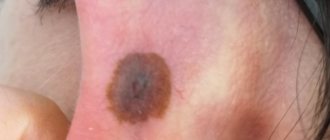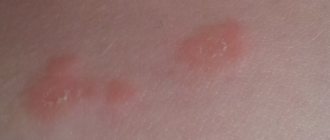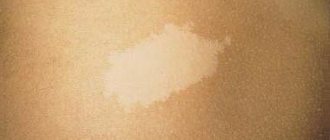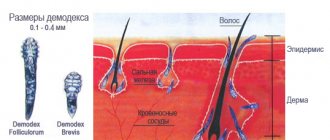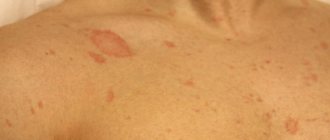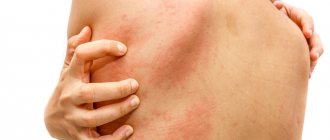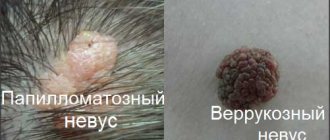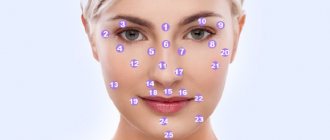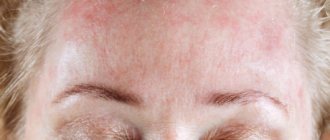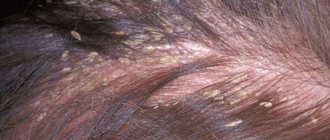What are the harbingers of purple spots on the skin? Should we be afraid of them? Can we ignore them? What are the factors in the development of this unusual phenomenon and how does skin damage occur in adults and children?
Subcutaneous hemorrhage is a common consequence of a mechanical shock, but the appearance of a wine-colored rash for no reason suggests that something is wrong with your health.
Types of rashes and the risks of their occurrence
Before you understand what it is and how it affects the body, it is necessary to describe the types of rashes, which differ in structure and color saturation.
Blue pigment formation can occur both from birth and after it. Acquired spots form at any age and are often associated with a blood clotting disorder.
There are 2 types of lesions:
- internal (develop due to disorders in the body);
- external (formed under the influence of mechanical stimuli).
In addition to injury, external causes are also associated with exposure to extremely high temperatures. If boiling water gets on the skin, the surface is scalded, so along with the bubbles a red and then bluish tint appears. “Marks” formed due to negligence remain for life, although they gradually fade over the years.
- long-term use of hormonal drugs;
- excessive intake of vitamin E;
- abuse of blood thinning medications (aspirin);
- alcohol addiction;
- excessively heavy physical labor;
- standing on your feet for a long time (risk of injury to the lower extremities).
If a purple or blue spot under the skin is found after childbirth, a birthmark is diagnosed. Acquired forms also include vascular nevi, since pigmented formations extremely rarely have a lilac tint.
Blue spots are a common consequence of overzealous cupping. The restoration of the natural shade occurs after 5–7 days.
Marbled skin syndrome - livedo
Livedo is the disease that develops in patients (medical term) who suffer from suddenly appearing bluish-purple streaks on the skin. Secondary disease is diagnosed mainly as a consequence of damage to internal organs and other pathologies.
There are other names for the disorders. One of them is livedo reticularis, which occurs due to atypical microcirculation. It most often occurs on the legs, less often on the torso.
Dangerous conditions - what are they?
Excessive rashes on the back, as well as other parts of the body, are a sign of a complex disorder in the body. During this period, they refuse to visit the bathhouse and sunbathe.
Diseases with a risk of acquiring disability:
- Thrombocytopenic purpura. The disease is dangerous due to the risk of internal hemorrhages, including in the brain. Laboratory confirmation of purpura is an extremely low number of platelets in the blood. Vascular dysfunction is often inherited, but sometimes occurs spontaneously.
- Capillary toxicosis. A sharply manifested symptom is the result of the entry into the body of an allergen (usually a food product) to which the person is intolerant. It often develops in children as a hypertrophied reaction to sore throat.
- Venous dilatation of veins (from stage 3). Although the defect appears in many patients in old age, the greatest risk is in those who have a complication. Advanced varicose veins lead to the appearance of dark areas of the dermis, which sometimes turn black. In this case, immediately consult a doctor: a change in shade is a symptom of necrotization. Appears in the arm area in 5% of cases.
- Kaposi's sarcoma. A malignant process that spreads chaotically throughout a person’s integument. The main danger is the rapid degeneration of small “marks” into 5-centimeter (in diameter) nodes.
A small red rash, especially in the legs, is sometimes the initial stage of thrombocytopenia, but more often the phenomenon occurs due to excessive exercise.
Intensive scratching of the skin with nails can also cause pinpoint but harmless changes. If vascular tone is disturbed, then formations - red moles - can remain on the body for a long time.
Facial erythema causes redness of the epithelium, and its complicated form causes a purple tint to the damaged dermis. Sharp but temporary changes are also possible with the development of drug photosensitivity in the chronic stage.
In the photos attached to the article, it is easy to determine which rashes appeared due to the oncological process, and which due to vascular pathology.
Spots on the body of elderly people | Cute freckles or a dangerous sign
Problems with the functionality of the kidneys or liver, stomach and intestines can cause the appearance of red spots on the legs below the knee. To determine the real cause of the pathology, you need to undergo an examination.
Redness of the legs above or below the knees: mechanical causes
First of all, you need to avoid rubbing and rubbing the skin of the extremities with clothing, furniture, and auxiliary devices. If spots on the skin appear due to contact with objects or inconvenient everyday life, then first of all it is necessary to exclude mechanical damage. Perhaps this will solve the redness problem.
Possible reasons
Red or purple spots may be a simple irritation due to the rough fabric of clothing or mechanical rubbing. In this case, it is enough to exclude the irritating element. It's worse if the irritation is caused by a disease.
Atopic dermatitis in older people
Small lumps are localized on the buttocks, thighs and knees.
Fungus
The spots are accompanied by peeling and itching. There are fewer and fewer healthy areas, and the affected skin constantly hurts.
Varicose veins
Vascular spots partially repeat the venous pattern on the legs.
Vasculitis
This is a systemic autoimmune lesion of the walls of blood vessels. The rash is localized below the knees and is accompanied by swelling and inflammation.
Diabetes
Large spots are localized on the legs and sometimes the knees. As the disease develops, the spots become bright burgundy.
Hemangioma
Benign vascular tumor. The spots do not hurt or itch, but have a risk of malignant degeneration.
Avitaminosis
Usually, with vitamin deficiency, the spots are small and dark.
Insect bites
Redness and rash from the bites of ants, mosquitoes, wasps, and midges are a completely natural reaction of a healthy body to the poison injected by insects.
Autonomic disorders
“Nervousness” may also cause itching and flaking as a result of scratching.
Eczema
Over time, the rash from eczema turns into small ulcers, the skin becomes covered with itchy blisters, and an inflammatory process develops.
Psoriasis
A rash in the form of pink plaques appears on joints, skin folds, and areas of skin covered by clothing. During exacerbation, the rash becomes brighter; during remission, the spots become lighter and may disappear completely. .
Lichen
An infectious disease that affects the entire length of the legs. The so-called shingles is concentrated on the thighs.
Burn
Depending on the depth of the lesion, the spots may be darker or lighter. The skin at the site of the spots is very sore and may come off in flakes or patches. The same symptoms characterize chapping and frostbite.
Heredity
If the parents had specific age-related pigmentation, then the children are likely to inherit it. But do not forget that following the rules of healthy eating and hygiene can significantly mitigate the symptoms.
Nutrition for brown spots on the face and hands
Brown age spots, which are small to medium in size and round to oval in shape, are the healthiest type of age-related pigmentation.
Foods high in vitamins PP and C will help slow down the appearance of age-related dark spots. For example, sour fruits, fresh herbs, dried mushrooms, carrots, prunes. The condition of the skin directly depends on the functioning of the digestive tract.
Spots in bedridden patients: red, blue, black - on the legs and body
If spots appear on the body of a bedridden elderly person, this cannot be ignored. This article lists the most common causes of stains, but it is always better to contact a specialist, even if you find a case very similar to yours. White spots
Such spots indicate insufficient blood flow to the cells and anemia. Small capillaries may stick together.
Red spots
In a bedridden elderly person, red spots signal the appearance of a bedsore, tissue death, and problems with the removal of waste products from cells.
Blue spots in a bedridden patient
Blue discoloration indicates tissue death, rupture of blood vessels, and necrosis.
Black spots
An alarming sign. The process of tissue melting deepens and affects neighboring tissues. A large abscess may form.
Blue spots only on legs
Lack of circulation in the lower extremities, blood clots and possibly respiratory failure
Marbled leather
Diseases of the nervous system, skin pathologies and impaired permeability of the vascular wall
Cadaveric spots
A symptom of approaching death in seriously ill patients. It does not always occur, but it definitely indicates the cessation of the functioning of all body systems
Convex dark spots on the face in older people
Flat large formations, senile lentigo, indicate a malfunction of the liver. They usually appear in very old age.
Senile freckles
A relatively harmless manifestation of age-related pigmentation. Small brown dots on the back of the hands and forearms indicate hormonal changes in the body.
Keratomas
Scaly yellow-brown spots anywhere are dangerous for degeneration into a malignant tumor.
Xanthelasma
Soft oval growths, which are more often found in women on the eyelids and cheeks.
What to do if you find spots on the lower extremities
If the spots on the legs differ in size and shape, are white, yellowish, brown, pink, red, itchy, wet or swollen, this may be a skin pathology. It is recommended to consult a dermatovenerologist.
If the spots form clusters, or turn into blisters, ulcers, or become crusty, you should contact an infectious disease specialist, as this may be a manifestation of measles or rubella.
Severe swelling and itching may indicate an allergy, so contact an allergist for testing and clarification of the diagnosis.
If large dark or, conversely, whitish spots (chloasis, vitiligo, leucoderma) appear on the legs, you should consult an endocrinologist and oncologist. They indicate a malfunction of the adrenal glands, thyroid gland, liver or kidneys.
Source: https://pro-vozrast.ru/uhod/pyatna_u_pozhilykh/
Age factor: children and elderly
Large purple spots on the skin of older people quickly form even with small impacts, since the walls of blood vessels become irreversibly thin after 50 years. Another defect is formed due to liver pathology, although the color of the spots is often brown rather than purple.
Thrombocytopenia also affects pensioners - this condition is called senile purpura, in which minor hemorrhages are diagnosed even without receiving a blow or the influence of other mechanical influences.
Anxiety grows when a rash is detected in a child, but pediatricians attribute most disorders to temporary defects. Rashes often appear due to a previous illness (cold), and the formations themselves always have a pale tint.
When a bright purple rash occurs, there is a risk of developing purpura. The most dangerous condition is meningococcemia, which develops due to sepsis. Children infected with the infection often die.
Types of neoplasms on the skin
When various kinds of problems occur in the functioning of any internal organ, the skin is one of the first to begin to react to such disturbances, and in some cases such a reaction is observed in the form of spots of different colors appearing on its surface. Purple or blue spots can form on the epidermis as a result of a violation of the integrity and structure of surface capillaries, however, in some cases, such neoplasms indicate the development of some serious pathological process in the human body. If blue spots on the body appear for no reason and are multiple in nature, then this is the first signal of the need to consult a specialist.
Macules, or skin spots, can appear on almost any part of the epidermis and have a variety of colors, ranging from flesh-colored to dark purple or brown. All macules are divided into:
The main reason for the occurrence of such skin tumors is a disruption in the production of melanin in a certain area of the epidermis. Thus, light or flesh-colored maculae are often one of the signs of excessive exposure of the human body to sunlight. This phenomenon mainly occurs among people who often vacation at seaside resorts. However, in addition to this, the causes of the appearance of light-colored spots on the skin can be all kinds of skin pathologies of a fungal nature, the development and progression of which disrupts the processes of normal production of melanin, a skin enzyme whose function is to regulate the color of the epidermis.
Wine-colored or dark-colored skin spots can be congenital, in which case they are called birthmarks, or moles (nevi). Such nevi can form in very young children, but often these neoplasms appear in people over the years. It is impossible to injure, or, even worse, remove birthmarks on your own due to the fact that this can provoke the transformation of a nevus into a malignant skin neoplasm.
Brown or light coffee-colored spots can appear as a result of excessive sun exposure. These macules are called freckles. They appear mainly in the warm season on the face or other parts of the body and gradually disappear with the onset of cold weather. In addition, this kind of skin tumors can appear in pregnant women, and in this case they are called “chloasma.”
Brown macules also occur in older people. Such neoplasms are also called liver spots, or lentigo. Such macules are larger than freckles and do not darken when exposed to solar radiation. Lentigines can be located both on the hands and on other parts of the body, including the face. The appearance of this kind of macula does not indicate the presence of any pathological processes in the human body and does not cause harm to his health, but is a natural physiological process that is a cosmetic defect. But the formation of black spots on a person’s skin can be a consequence of various diseases of the adrenal glands or an endocrine disease such as diabetes.
Treatment methods
If the spots are red or pink, then the cause is an internal infection. In this case, medications are prescribed that contain keratolytics and fungicides. Efficiency differs:
- Clotrimazole - taken three times a day;
- ten percent sulfur ointment - applied twice a day to the affected skin;
- ointment with salicylic acid - used as a replacement for sulfuric ointment.
Freckles can be removed with cosmetic procedures in the salon. The accumulation of pigments can be observed in different layers of the skin: in the epidermis (upper layer) and dermis (deep layer). Cosmetologists recommend removing only those pigments that are located on the surface of the skin. Treatment methods:
- chemical peeling – carried out using acids. This method lightens pigments and cleanses the epidermis of the stratum corneum. Peeling is recommended to be done in winter, as the skin becomes too sensitive to light;
- photo-treatment – removal of pigments using light rays. Photorejuvenation is painless, but the skin takes a long time to recover;
- cryomethod – treatment of freckles with liquid nitrogen;
- laser – reduces the brightness of pigments gradually. The use of laser beams is the safest.
- professional procedures;
- use of creams with lactic acid;
- proper nutrition - eating fresh fruits and vegetables, a balanced supply of all necessary substances to the body;
- traditional methods of treatment - the use of masks with lemon juice, parsley and fermented milk products.
Causes of purple spots
In most cases, the bluish or purple tint of the skin tumor is of vascular origin. In this regard, this kind of spot on the epidermis can arise as a result of mechanical damage to one of its areas, which also causes damage to the structure of the surface capillaries. Mechanical damage to one or another part of the epidermis occurs due to injury or bruise. However, in some cases, the appearance of purple macules may indicate the occurrence of various pathologies in the human body that affect its vascular system. Such diseases include meningococcemia, thrombocytopenic purpura and capillary toxicosis. Most often, purple macules appear on the inner surfaces of the hands, forearms or ankles of a person.
Prevention
Preventive measures will help minimize the risk of age spots, but it is a mistake to consider them a panacea.
- Do not overuse tanning in the sun or in a solarium. It is necessary to avoid sunbathing between 11 and 17 hours of the day. When exposed to ultraviolet rays, you should use sunscreen.
- Strengthen the immune system, maintain a drinking regime, and balance your diet.
- You should not use medications without consulting a doctor (we are talking about long courses of use).
- Regularly undergo medical examinations and medical examinations to identify the disease in the early stages.
Kaposi's sarcoma and purple spots
Kaposi's sarcoma is characterized by the appearance of small dark purple skin tumors that occur in a person due to the presence of AIDS or as a result of undergoing transplantation of any internal organs. This phenomenon occurs against the background of the development of a malignant tumor in the gastrointestinal tract. Most often, neoplasms affect the mucous membrane of the stomach, small intestine or large intestine.
The risk group for developing a disease such as Kaposi's sarcoma includes:
- elderly and male people;
- HIV-infected people;
- people who have type 8 herpes virus in their body.
The spots that form on a person’s skin during the development of Kaposi’s sarcoma disease are similar in appearance to specific rashes of a purple or blue hue and look like rounded small nodules, the size of which can reach 50 mm in diameter. Moreover, such maculas are accompanied by painful sensations if pressure is applied to them.
Treatment of this pathological process involves the use of local and systemic use of various chemotherapeutic drugs and radiation therapy that directly affects the tumor.
Flaming nevus and skin spots
Flaming nevus is a pathological process that is characterized by a violation of the structure and integrity of the vessels of the human circulatory system, located quite close to the skin. This disease is a type of dysplasia. Popularly, flaming nevus has a name such as port-wine stains because of the characteristic purple subcutaneous growths. This pathological process develops in a child during the period of intrauterine development.
Flaming nevus appears as irregularly shaped macules and does not disappear throughout life. Sometimes the development of such a disease may be one of the symptoms of the presence of genetic pathologies such as:
- Rubinstein-Taybi syndrome;
- Cobb syndrome.
Treatment of a flaming nevus is carried out only by completely removing it using laser radiation or cryotherapy (freezing the pathological area of the skin).
The appearance of spots of any size and color on the skin should not be ignored, and therefore, if you discover such a phenomenon, you must consult a doctor who, if necessary, will prescribe an appropriate course of treatment.
The skin is not just a shell of the body, it is an independent organ, and the largest one if you compare the surface area and its weight. The body needs skin primarily to protect against bacteria, as well as to regulate temperature and transmit information about pain, heat or cold. The skin reacts both to external factors (sun rays, chemicals) and to the general condition of the internal organs. If something is wrong inside, then it is she who is the first to give signals, sometimes manifesting itself in the form of spots. The appearance of purple spots on the skin can be caused by both a violation of the integrity of the capillaries and the development of serious diseases. If such spots appear for no reason, you should consult a doctor.
Do you still think that getting rid of age spots is difficult?
Judging by the fact that you are reading this article, victory was not on your side. And of course you know firsthand what it is:
- again refuse an evening with friends because of hated stains
- cover freckles with concealer and foundation every day
- constant ridicule
- not effective traditional methods
Now answer the question: are you satisfied with this? Can freckles be tolerated? How much money have you already wasted on ineffective treatment? That's right - it's time to end them! Do you agree? That is why we decided to publish an exclusive interview in which the secret of getting rid of freckles and achieving the ideal complexion is revealed. Read the interview.
Types of spots on the skin
Spots (macula) on the skin can have a wide variety of colors - pink, blue, wine, purple. They differ from normal skin only in color and sometimes peel.
Any spots that already exist or have just appeared on the skin are divided into:
Spots on the body can be either light (a sign of hypochromia) or dark, for example, purple (hyperchromia). The reason for their appearance is a violation of skin coloration. Light-colored spots are very often a sign of overexposure to the sun's rays, and lovers of non-sea holidays may encounter this problem.
Another reason for the appearance of light spots on the skin may be fungal or other skin diseases that disrupt the production of melanin, which is responsible for the color of the skin. With a congenital disorder of this process, albinism can occur, when all the skin, hair and iris are completely white.
Bruises after injections
In some cases, due to existing reasons, blue spots on the body of children appear after the injection. A child’s bruise can be caused by an injection:
- a short needle attached to a syringe;
- accelerated pace of drug administration (cotton method);
- muscle spasms;
- allergic reaction to the administered drug.
If swelling and dark color form at the injection site, you need to apply anti-bruise ointment for children or iodine mesh to the affected area of the body. The use of Vishnevsky, troserutin, heparin and bruise-off ointments will soon reduce dark manifestations on the child’s body.
Varicose veins worry women most of all, but the disease is also quite common among men. But at the same time, the strong half of humanity is not as worried about the external condition of their legs as girls and women. After all, varicose veins necessarily manifest themselves as large swollen veins on the legs and, in some cases, even an extensive vascular network.
For any representative of the fair sex this is a disaster. And in addition to all the manifestations described above, blue spots often appear with varicose veins, which most often are subcutaneous nodules. They can be either blue or purple. Moreover, in some cases, it is with blue spots on the legs that the first manifestations of varicose veins begin.
Purple spots: reasons for their appearance
Purple spots, like pink ones, are of vascular origin. Why might they appear? This is either a consequence of damage to the capillaries (an example of this is bruises after bruises), or symptoms of serious diseases (capillary toxicosis, thrombocytopenic purpura, meningococcemia).
A black-blue bruise appears after a bruise or injury, but with purple, the spot appears for no apparent reason and does not disappear or fade when you press on it. Purpura may appear as large spots or as small speckles (petechiae). Most often, purple (port-wine) stains are found on the shins, forearms, or inner surfaces of the arms.
If purple or port-wine stains, which were mistaken for a bruise, persist and do not go away for a long time, then most likely this is a subcutaneous leak of blood from the vessels, or purpura.
This skin condition can have several possible causes, ranging from scurvy to poor blood clotting. But if we take older people, then they most often develop port-wine (purple) stains due to the thinning of the walls of blood vessels and their weakening and are known as senile purpura. Port-wine or purple spots on the surface of the body may appear due to excessive use of vitamin E, non-steroidal anti-inflammatory drugs, aspirin, blood thinners, alcohol or steroids.
If you have large bruises or purple spots that don't go away for a long time, you should consult a doctor. Also, the reason for a medical examination should be cases of frequent and easy bruising on the body - they may indicate vascular bleeding.
Features of retroperitoneal hematoma
This pathological condition occurs much less frequently than any other. A retroperitoneal or retroperitoneal hematoma is a pocket of blood located in the lower back, known as the retroperitoneum. A hematoma forms when blood collects in an enclosed area, such as soft tissue, among organs and their supporting membranes. Peritoneal cavity, the space formed between two types of membranes surrounding the organs of the peritoneum and pelvis. The retroperitoneum is the area found behind the peritoneum.
The retroperitoneal organs include those in the lower back that are not supported by the peritoneal lining. These include the pancreas, kidneys and adrenal glands, and duodenum. The zone also includes vessels such as the aorta and the inferior vena cava. Bruises on the abdomen often occur for no reason in women; this process is preceded in some cases by a pathological process, so this manifestation should not be underestimated.
A retroperitoneal hematoma is most often caused by traumatic impact on the body or injury caused by a foreign object penetrating the abdominal cavity or pelvic area. The internal bleeding that occurs with these types of injuries accumulates to form a hematoma. The large vessels of the vena cava and aorta, as well as the vessels that support the retroperitoneal organs, may be damaged, causing initial bleeding.
Kaposi's sarcoma spots
The appearance of purple spots on the skin is possible with a disease such as Kaposi's sarcoma. Malignant neoplasms can occur in people with AIDS or who have undergone organ transplantation. The tumor most often occurs in the small intestine, stomach, or lower colon. The disease, as a rule, does not have specific, pronounced symptoms; sometimes blood and protein may be present in the stool, or diarrhea may appear. Another manifestation of the disease is intussusception, or the penetration of part of the intestine into a nearby part, and as a result, its obstruction.
People who are at risk for Kaposi's sarcoma have:
- elderly age;
- HIV infection;
- male gender;
- organ transplantation;
- infection with herpes virus type 8;
- African origin.
If symptoms of the disease occur in people from this group, then the doctor may first suspect the presence of Kaposi's sarcoma. An accurate diagnosis is established only after removal of the affected area of the intestine and subsequent examination of the diseased tissue. There is only one treatment for this disease - surgery.
Spots of any color that appear on the skin can be a signal of a malfunction of the body that cannot be ignored. The most correct action would be to visit a doctor, who will determine the nature of the spots and, if necessary, prescribe appropriate treatment.
Professional skills : Chief physician of the medical center, practicing cosmetologist.
Brief biography and personal achievements : Teaching activity: teaching the subject “Social Medicine and Healthcare Organization”, including for foreign (English-speaking) students, conducting consultations and pre-exam preparation.
Scientific and research activities : writing scientific publications, accompanying documents, organizing interaction of the department with specialized leading clinical and cosmetology centers for joint research work, participation in conferences, symposiums, etc.

